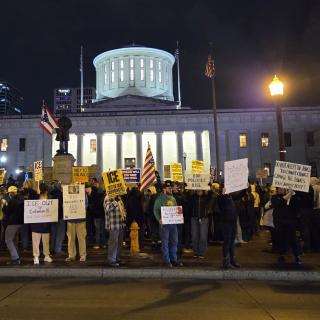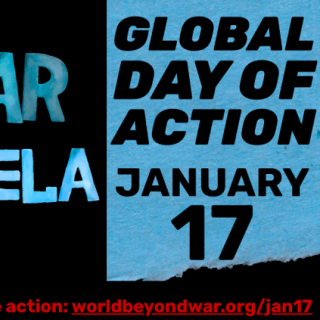Advertisement
This morning, employees at Columbus’ 88 E. Broad St. Starbucks location delivered a letter to Starbucks’ CEO announcing that they “choose to join in the national labor movement of Starbucks stores.”
The Starbucks location in the heart of downtown is the first in Columbus to announce a union drive, joining three other locations in Ohio and more than 140 across the country in attempting to unionize. “We know your company can be better, and we choose to stay and help it grow from within,” they wrote.
The store in the Key Bank building facing 3rd street serves government employees, office workers, downtown residents, houseless community members, and tourists.
“We get a good mix of people,” says Damon Shnur who’s worked at this downtown Starbucks for nine years and is part of the location’s organizing committee for the union drive. “I think a lot of our clientele is also just very excited for us. They’re very excited about unionizing in general, but I think they will be very excited and supportive of us.”
The buildup to this nationwide unionization effort – officially known as Starbucks Workers United – started at the beginning of the pandemic. In that early confusion surrounding the severity of the virus, as other companies sent their employees home, Starbucks continued to operate. This stirred employees at Columbus location into action.
“It felt like something needed to happen and it wasn’t going to happen by the company, and it was really up to us as individuals,” recalls Ben Baldwin, a decade-long employee with Starbucks and organizing committee member at the downtown location.
It was a Friday evening in 2020 when employees at the 88 East Broad location decided that if the company wasn’t going to address the problem then they’d stage a walk-out on that Monday. But just before Monday came around, Starbucks finally announced they’d temporarily close their location for two weeks, which got pushed to a month. So the walkout didn’t take place, but it was still a turning point for the workers.
“That’s for me where the seeds were planted for this,” Baldwin said.
Starbucks then mobilized to take the pandemic seriously, switching to a “to go” model that kept customer interaction to a minimum, organizing shifts to maintain space for social distancing, and offering an extra $3-an-hour hazard pay.
But this was short lived. A few months later, the $3 was rolled back, they resumed normal cafe service, started to reduce shift hours, and offered severance packages.
“There was a choice of well you could leave and not have a job in this very uncertain condition of working or you could stay and possibly not make enough money, but also still have to deal… with being an essential worker during a pandemic,” Shnur reflected. “And I think that really resonated with a lot of us just feeling that the company had abandoned us and our safety.”
During the winter break of 2021, a young Columbus College of Art and Design (CCAD) student and Starbucks employee, Jesse Perry, was working intensely at a busy Starbucks location in upstate New York. He described long drive-thru lines wrapping around the building into the road, working a drive-thru window in freezing temperatures for long hours, short breaks, and little concern from management.
“There’s just no time to do what Starbucks wants us to do… with these high-volume stores and all of the partners are super overworked. It was just an absolute nightmare,” said Perry.
When he got back to working at the 88 E. Broad St. location in Columbus, he told his fellow employees about the stressful experience and was surprised to hear his more experienced colleagues confess that every other Starbucks is just as intense. “It’s just very touching, but painful to hear what everyone’s experience with the company has been.”
In that same month, workers at a Buffalo, NY Starbucks voted to unionize, becoming the first to do so in the US. This sparked a new flame for the East Broad location. After Perry was told of the terrible conditions across the country, he found himself asking what his fellow employees thought about Buffalo unionizing.
“I went around to all my co-worker’s one-on-one, and I brought it up to them and the vast majority were really excited,” he said. That’s when they began researching what it would look like to actually form a union at their location, establishing contact with Starbucks Workers United, a subset of Workers United, a union affiliated with the Service Employees International Union (SEIU).
Starbucks’ response to the massive spread of union drives across the country has been a multi-million dollar anti-union effort, creating an uphill battle for workers. But the intimidation tactics haven’t stopped the acceleration of unionizing efforts.
Baldwin sees the union as serving two main purposes for the downtown location. First, to have more of a say in their work environment. “It would be nice to have the power to say ok there is community spread, we should start masking again in the store and not have to wait for Starbucks at the national level to say ok enough people have been hospitalized we should start masking again,” he said.
The second is the increase in wages and benefits that come with having a union. The Bureau of Labor Statistics found that union workers continue to make higher wages with better benefits compared to non-union workers, even though union membership has been on the decline in the past decades.
“We need more money to have any kind of sustainable life,” Baldwin says, arguing that a union would only benefit Starbucks. Now, the 12 optimistic Starbucks employees of the East Broad location have to make it to the union election, the date of which will be decided in the coming weeks or months.
“Everyone I work with truly does love their job, they love the people that we see every single day, the people we serve every single day, we love seeing each other every single day,” says Perry, the youngest member of the organizing committee. “You don’t get up at 4 in the morning to go to work with people that you don’t like. You do it because you love it and we all really care about what we do, it’s just that we want to also feel cared about, we also want to feel valued in turn, and compensated and treated as if we matter.”



